EOS Contest Exposes Local Kids to EOH, Engineering
March 21, 2017
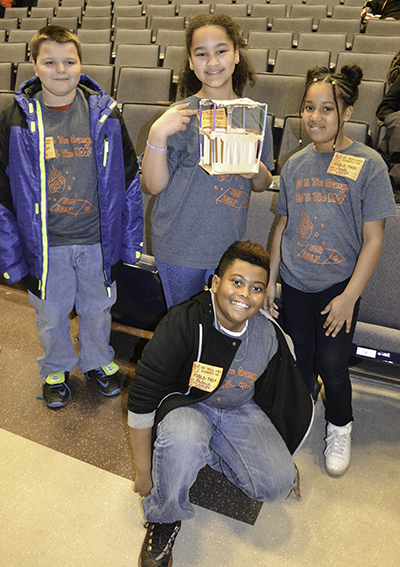
Above: a team of students proudly shows off the house they designed—pre testing.
Below: The team above just as proudly shows off its rather dilapidated house— post the bonus round.
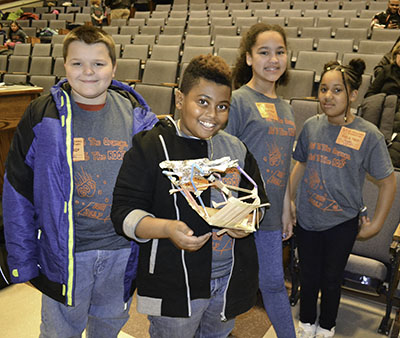
“Hail to the Orange, Hail to the Roof!” This was emblazoned in bright orange on the front of the blue t-shirts more than 200 local 1st, 3rd, and 4th grade students wore as they invaded Engineering Open House (EOH) on Friday, March 10. They showed up to participate in the Engineering Outreach Society (EOS) engineering contest. Their main goal? To determine how well the house their team had constructed— particularly the roof—would stand up to the test: an avalanche of “hail” stones EOS members poured down upon their model. Whether they experienced the thrill of victory (as their model stood up to the deluge of stones) or the agony of defeat (as their building was virtually decimated), the students had fun, experienced the thrill of competition, and got a taste of what engineering is like.
According to Cavita Desai, the engineering physics major in charge of the contest, EOS holds a contest with elementary school students every year. For this year’s, “Hail to the Orange, Hail to the Roof” (whose cutesy name was partially plagiarized from the Illinois Loyalty, “Hail to the Orange, Hail to the Blue…”), the kids were to design then build houses that could withstand damage from hail. “So they had to take into consideration materials and how well their structures could stand against having something hitting it constantly,” says Desai.
So back in the third week of January, EOS members visited the participating 1st, 3rd, and 4th grade classrooms of the two Urbana schools involved (Dr. Williams and Leal) to teach them some engineering principles, lay the contest's ground rules, and oversee the project. Students were divided into groups, with three to six students per group; there were 43 entries all total. Then students had one week to plan and five weeks to build their project, using a variety of materials: popsicle sticks, straws, tin foil, tape, etc. And, of course, for the pièce de résistance of the contest…they attended EOH as guests of EOS, where each house would be tested.
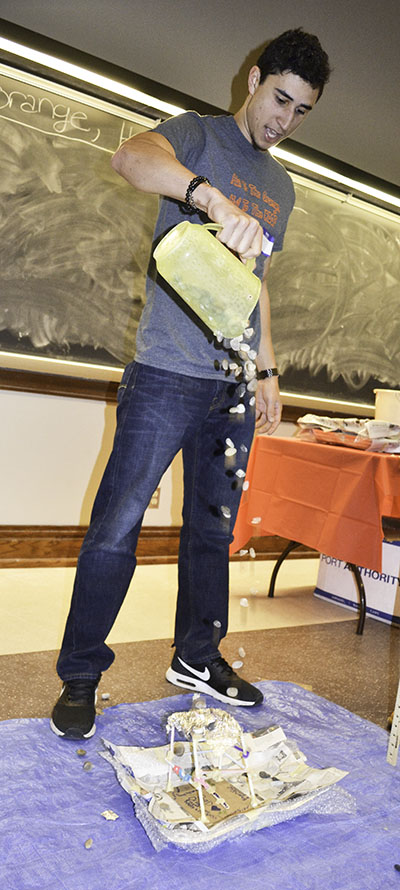
An engineering student performs the round 1 test on a house...a pitcherful of smaller stones.
Testing involved bombarding each house with three containers of rocks. To ensure fairness in testing, one EOH member would hold a yardstick, so the bucket would be at a uniform height throughout all of the tests.
For the first round, a pitcher of smaller-sized rocks was dumped on the house. If the house withstood the first test (most did), a second then a third bucket filled with increasingly larger stones was dumped on the house. If a house made it past the first three rounds, the team was given the option of subjecting their house to a final, bonus round (a bucket full of REALLY GINORMOUS rocks which, in all fairness, was proportionally like exposing a real house to automobile-sized hail stones.) Practically no house stood up through the final bonus round, but teams proudly posed for photos with their flattened houses, grinning anyway. It was all in good fun, and clearly, the EOS students had as much fun dumping the rocks as the elementary students did watching their houses being flattened.
Plus, the young students learned some valuable lessons through the project...how to design something according to certain specifications, with certain materials, and in a specific timeframe; teamwork; and how to fail. They learned that in engineering, sometimes your design doesn't work, and you have to go back to the drawing board.
While at EOH, students got further exposure to engineering. When not in testing, they got to visit many different exhibits. (They also, no doubt, took advantage of the proximity of a cotton-candy-spinning machine and a chocolate tempering exhibit with Dove samples just down the hall from the contest).
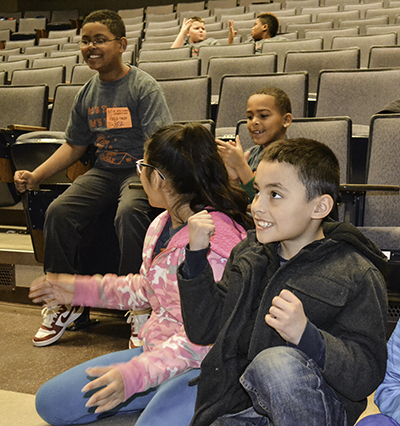
Above: The thrill of victory.
Below: The agony of defeat.
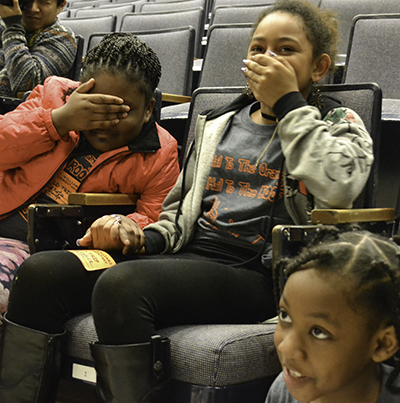
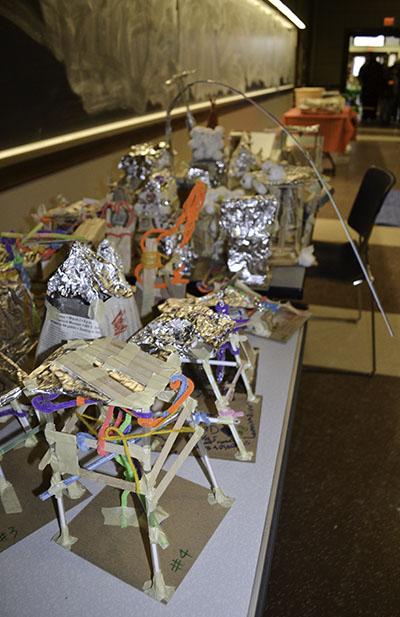
The 43 houses stoically await their doom. Close to the back is the house with the tallest tower, which had been constructed of straws.
Why does EOS do this contest every year? Their goal is expose youngsters to STEM.
“I love working with kids,” admits Desai. “I am so excited to get started. It’s just amazing to see what they come up with, and they can be so innovative. And they get to practice STEM at such an early age. And just to have them come up here and not just see our exhibit, but to see other exhibits and to start inspiring their minds.”
Teams could win in several different categories, such as the tallest tower, the shortest house, the heaviest; plus teams could win points for creativity. According to Desai, some students actually built tee pees:
“It’s interesting to see what they define as a house and a roof,” she admits. “So this is one group’s definition of the tallest tower (she points to a very tall tower). And just to see their creativity is so inspiring.”
The houses had all been turned in ahead of time, judged, and winners assigned in the various categories. There’s just one catch: the house must have survived the testing to be the winner of the category.
If a team’s house survived the bonus round, did they win a prize? Nope, it was just for fun.
While the engineering skills the kids learned in designing their house would probably technically be classified as Civil Engineering, EOS students didn’t differentiate when explaining the contest to the kids:
“We explained to them that engineers do all sorts of different things," explains Desai, "and that engineering is such a broad scope with project design, and teamwork. That was kind of the goal of the project.”
Story & photographs by Elizabeth Innes, Webmaster, I-STEM Education Initiative.
For an aditional I-STEM articles about Engineering Open House, see:
- Students/Alumni Promote Engineering at Illinois During EOH 2016
- Engineering Open House 2015 Looks to the Future
- Engineering Students Enjoy Exposing Visitors to STEM During EOH 2014
More: Engineering Open House, K-12 Outreach, Open House/Expos, 2017.
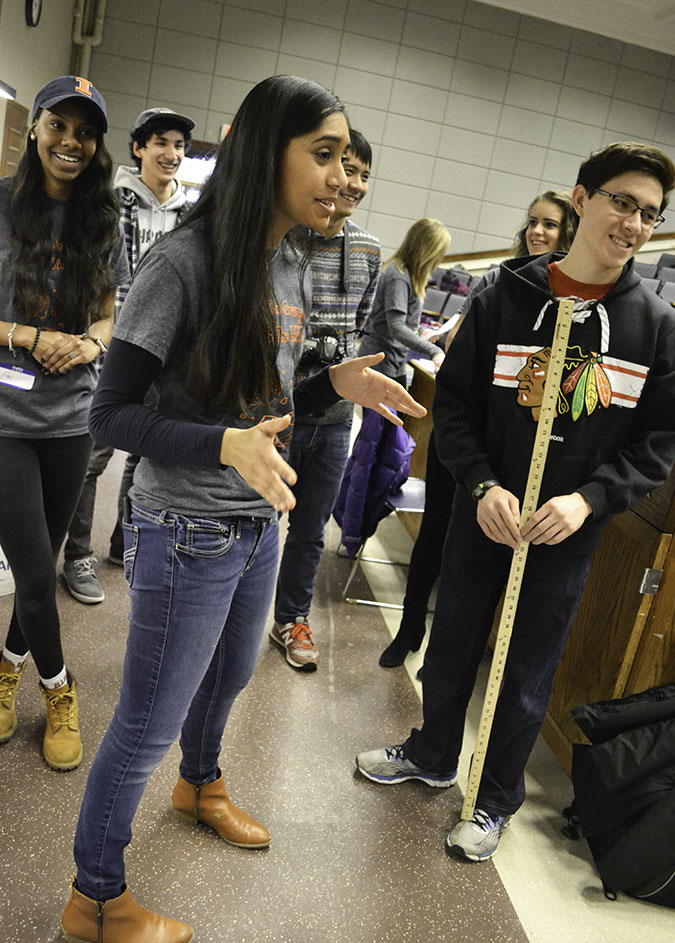
Cavita Desai (center) and her team of EOS engineering students interact with the elementary students during the contest.













.jpg)
















